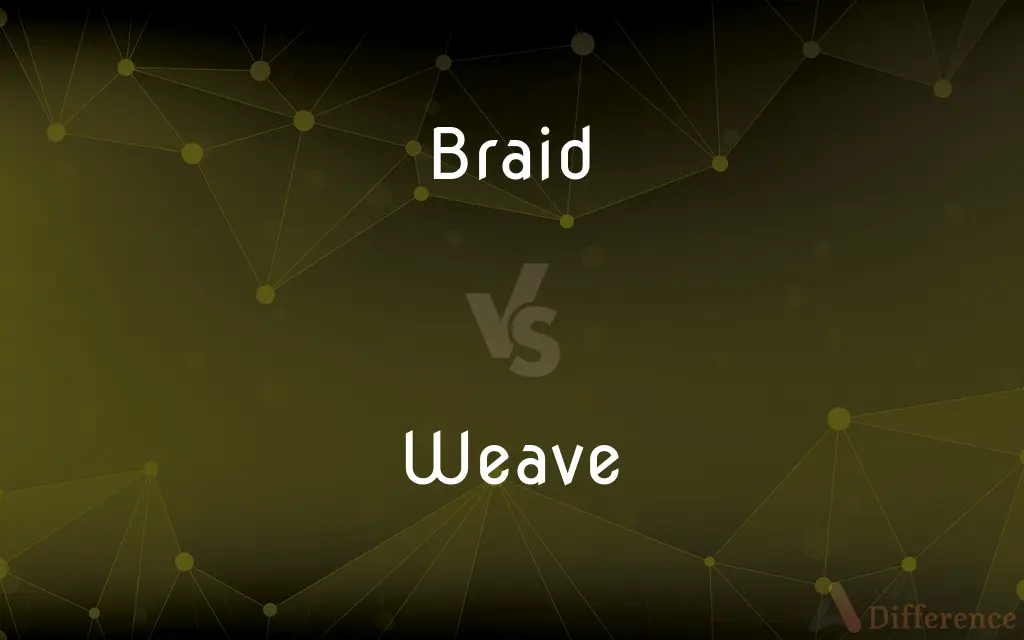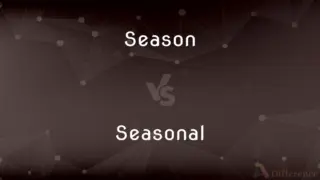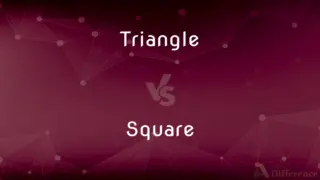Braid vs. Weave — What's the Difference?
By Tayyaba Rehman & Maham Liaqat — Updated on March 28, 2024
Braiding intertwines three or more strands of hair close to the scalp for various styles, while weaving involves sewing extensions into braided hair for added length or volume.

Difference Between Braid and Weave
Table of Contents
ADVERTISEMENT
Key Differences
Braiding involves intricately intertwining three or more strands of hair to create a wide range of styles, from simple plaits to complex patterns, directly on the scalp or along the hair's length. Weaving, on the other hand, is a method of adding hair extensions by sewing them into a base of tightly braided cornrows, offering an effective way to add length, volume, or even color without altering the natural hair.
While braiding can be a style on its own or a foundation for extensions, it's generally considered less permanent than weaving and can be a protective hairstyle that minimizes hair manipulation and exposure. Weaving, however, provides a more lasting hairstyle that can fully cover the natural hair, serving as a protective style but requiring more maintenance to prevent damage to the underlying hair and scalp.
Braids can be easily done at home with minimal tools and are adaptable to various hair lengths and types, making them a versatile and accessible option for many. Weaves typically require a professional stylist to install the extensions securely and blend them with the natural hair, involving more time and expense.
Braids offer a way to express cultural identity and creativity, with roots in African, Native American, and other cultures worldwide. While weaves also allow for cultural expression and versatility, they often focus more on achieving a particular aesthetic or look that may not be possible with one's natural hair alone.
The maintenance of braids usually involves regular cleansing and moisturizing to keep the hair healthy, whereas weaves require careful washing, drying, and sometimes tightening to maintain their appearance and protect the health of the natural hair beneath.
ADVERTISEMENT
Comparison Chart
Definition
Intertwining of three or more strands of hair.
Sewing hair extensions into braided hair.
Primary Use
Creating various hairstyles directly on the scalp.
Adding length, volume, or color to natural hair.
Installation
Can be done at home or by a professional.
Typically requires professional installation.
Duration
Less permanent, varies with style.
More lasting, often requires maintenance.
Maintenance
Involves regular cleansing and moisturizing.
Requires washing, drying, and professional upkeep.
Cultural Significance
Expresses cultural identity and creativity.
Focuses on aesthetic enhancement.
Versatility
Adaptable to many hair lengths and types.
Offers dramatic changes in appearance.
Protective Nature
Minimizes hair manipulation and exposure.
Covers and protects natural hair, but needs care.
Compare with Definitions
Braid
A hairstyle created by intertwining strands of hair.
She wore a beautiful braid to the wedding.
Weave
A method of adding hair extensions for length or volume.
She got a weave to achieve longer, fuller hair instantly.
Braid
Braids can vary from simple three-strand styles to complex designs.
For the festival, she chose an intricate braid pattern.
Weave
Allows for dramatic changes in hair appearance.
The weave transformed her look completely, giving her a confidence boost.
Braid
A protective hairstyle that can reduce hair manipulation.
He kept his hair in braids to prevent breakage.
Weave
Can be used to experiment with colors without dyeing.
With a weave, she tried out blonde hair for the first time.
Braid
Easy to maintain and versatile.
She loves braids for their easy upkeep and the ability to fit any occasion.
Weave
Offers a protective style but needs careful maintenance.
While her weave protected her natural hair, it required regular salon visits.
Braid
Braids have been a part of many cultures for centuries.
Braids in her culture symbolize wealth and status.
Weave
Requires professional installation to blend with natural hair.
Her weave was so well done, it looked like her natural hair.
Braid
A braid (also referred to as a plait) is a complex structure or pattern formed by interlacing two or more strands of flexible material such as textile yarns, wire, or hair. Braids have been made for thousands of years, in many different cultures around the world, for a variety of uses.
Weave
To make (cloth) by interlacing the threads of the weft and the warp on a loom.
Braid
Threads of silk, cotton, or other material woven into a decorative band for edging or trimming garments
Fancy braids
A coat trimmed with gold braid
Weave
To interlace (threads, for example) into cloth.
Braid
A length of hair made up of three or more interlaced strands
Her hair curled neatly in blonde braids
Weave
To construct by interlacing or interweaving strips or strands of material
Weave a basket.
Braid
Interlace three or more strands of (hair or other flexible material) to form a length
Their long hair was tightly braided
Weave
To interweave or combine (elements) into a complex whole
Wove the incidents into a story.
Braid
Edge or trim (a garment) with braid
Braided red trousers
Weave
To contrive (something complex or elaborate) in this way
Weave a tale.
Braid
(of a river or stream) flow into shallow interconnected channels divided by deposited earth or alluvium
A braided river carries an enormous burden of sand and gravel
Weave
To introduce (another element) into a complex whole; work in
Wove folk tunes into the symphony.
Braid
To interweave three or more strands, strips, or lengths of in a diagonally overlapping pattern
Braided the rags into a strong rope.
Weave
To attach hair extensions to (hair).
Braid
To create (something) by such interweaving
Braid a rug.
Weave
To spin (a web, for example).
Braid
To style (the hair) by such interweaving.
Weave
Past tense & past participle often weaved To make (a path or way) by winding in and out or from side to side
Weaved our way through the heavy traffic.
Braid
To mingle (discrete elements, for example) as if by such interweaving
Braided the ideas into a complex thesis.
Weave
To engage in weaving; make cloth.
Braid
To decorate or edge (something) with a trim of interwoven strands
Finished the jacket by braiding the collar and cuffs.
Weave
To work at a loom.
Braid
To fasten or decorate (hair) with a band or ribbon.
Weave
Past tense and past participle often weaved To move in and out or sway from side to side.
Braid
To flow, twist, or wind as if interwoven
A stream braiding through the woods.
Weave
The pattern, method of weaving, or construction of a fabric
A twill weave.
A loose weave.
Braid
A braided segment or length, as of hair, fabric, or fiber.
Weave
A hairstyle in which hair extensions are attached to existing strands of hair.
Braid
Ornamental cord or ribbon, used especially for decorating or edging fabrics.
Weave
To form something by passing lengths or strands of material over and under one another.
This loom weaves yarn into sweaters.
Braid
A ribbon or band used to fasten the hair.
Weave
To spin a cocoon or a web.
Spiders weave beautiful but deadly webs.
Braid
To make a sudden movement with, to jerk.
Weave
To unite by close connection or intermixture.
Braid
To start into motion.
Weave
To compose creatively and intricately; to fabricate.
To weave the plot of a story
Braid
(transitive) To weave together, intertwine (strands of fibers, ribbons, etc.); to arrange (hair) in braids.
Weave
(intransitive) To move by turning and twisting.
The drunk weaved into another bar.
Braid
To mix, or make uniformly soft, by beating, rubbing, or straining, as in preparing food.
Weave
(transitive) To make (a path or way) by winding in and out or from side to side.
The ambulance weaved its way through the heavy traffic.
Braid
(obsolete) To reproach; to upbraid.
Weave
To move the head back and forth in a stereotyped pattern, typically as a symptom of stress.
Braid
(obsolete) A sudden movement; a jerk, a wrench.
Weave
A type or way of weaving.
That rug has a very tight weave.
Braid
A weave of three or more strands of fibers, ribbons, cords or hair often for decoration.
Weave
(cosmetics) Human or artificial hair worn to alter one's appearance, either to supplement or to cover the natural hair.
Braid
A stranded wire composed of a number of smaller wires twisted together
Weave
To unite, as threads of any kind, in such a manner as to form a texture; to entwine or interlace into a fabric; as, to weave wool, silk, etc.; hence, to unite by close connection or intermixture; to unite intimately.
This weaves itself, perforce, into my business.
That in their green shops weave the smooth-haired silkTo deck her sons.
And for these words, thus woven into song.
Braid
A tubular sheath made of braided strands of metal placed around a central cable for shielding against electromagnetic interference.
Weave
To form, as cloth, by interlacing threads; to compose, as a texture of any kind, by putting together textile materials; as, to weave broadcloth; to weave a carpet; hence, to form into a fabric; to compose; to fabricate; as, to weave the plot of a story.
When she weaved the sleided silk.
Her starry wreaths the virgin jasmin weaves.
Braid
(obsolete) A caprice or outburst of passion or anger.
Weave
To practice weaving; to work with a loom.
Braid
To weave, interlace, or entwine together, as three or more strands or threads; to form into a braid; to plait.
Braid your locks with rosy twine.
Weave
To become woven or interwoven.
Braid
To mingle, or to bring to a uniformly soft consistence, by beating, rubbing, or straining, as in some culinary operations.
Weave
A particular method or pattern of weaving; as, the cassimere weave.
Braid
To reproach. [Obs.] See Upbraid.
Weave
Pattern of weaving or structure of a fabric
Braid
To start; to awake.
Weave
Interlace by or as it by weaving
Braid
A plait, band, or narrow fabric formed by intertwining or weaving together different strands.
A braid of hair composed of two different colors twined together.
Weave
Create a piece of cloth by interlacing strands of fabric, such as wool or cotton;
Tissue textiles
Braid
A narrow fabric, as of wool, silk, or linen, used for binding, trimming, or ornamenting dresses, etc.
Weave
Sway to and fro
Braid
A quick motion; a start.
Weave
To move or cause to move in a sinuous, spiral, or circular course;
The river winds through the hills
The path meanders through the vineyards
Sometimes, the gout wanders through the entire body
Braid
A fancy; freak; caprice.
Braid
Deceitful.
Since Frenchmen are so braid,Marry that will, I live and die a maid.
Braid
A hairdo formed by braiding or twisting the hair
Braid
Trimming used to decorate clothes or curtains
Braid
Make by braiding or interlacing;
Lace a tablecloth
Braid
Decorate with braids or ribbons;
Braid a collar
Braid
Form or weave into a braid or braids;
Braid hair
Common Curiosities
What is a weave?
A weave involves adding hair extensions by sewing them into braided cornrows to enhance the hair's length, volume, or color.
How long does a weave last?
A weave can last up to 8 weeks with proper care, but it may require tightening or adjustments.
Can braids damage hair?
Braids can protect hair from damage if done properly; however, tight braiding can lead to tension and breakage.
How do you care for braids?
Keep braids clean, moisturize regularly, and avoid excessive tension.
Are braids suitable for all hair types?
Yes, braids can be adapted to suit most hair types and lengths.
How long can braids last?
Braids can last from a few days to several weeks, depending on the style and maintenance.
Can braids and weaves promote hair growth?
They can protect hair from daily wear, potentially aiding growth, but require proper care to prevent damage.
Why might someone choose a weave over braids?
Someone might choose a weave for more length, volume, or to try a new color without altering their natural hair.
What is a braid?
A braid is a hairstyle created by intertwining three or more strands of hair.
How do you maintain a weave?
Wash carefully, dry thoroughly to prevent mildew, and visit a stylist for upkeep.
Can braids be a permanent hairstyle?
Braids are not permanent; they need to be redone periodically to maintain the style and health of the hair.
Can weaves damage hair?
Weaves can protect natural hair but might cause tension and stress if too tight, leading to potential damage.
What cultural significance do braids hold?
Braids hold significant cultural meanings, symbolizing status, identity, and heritage in many societies.
Can anyone get a weave?
Weaves are versatile but work best on hair that can sustain tight braiding for the base.
Are weaves more expensive than braids?
Yes, weaves generally cost more due to the need for additional hair extensions and professional installation.
Share Your Discovery

Previous Comparison
Season vs. Seasonal
Next Comparison
Triangle vs. SquareAuthor Spotlight
Written by
Tayyaba RehmanTayyaba Rehman is a distinguished writer, currently serving as a primary contributor to askdifference.com. As a researcher in semantics and etymology, Tayyaba's passion for the complexity of languages and their distinctions has found a perfect home on the platform. Tayyaba delves into the intricacies of language, distinguishing between commonly confused words and phrases, thereby providing clarity for readers worldwide.
Co-written by
Maham Liaqat













































